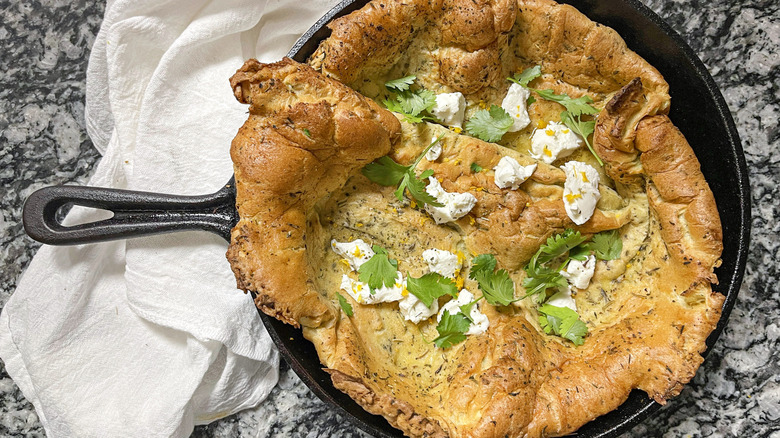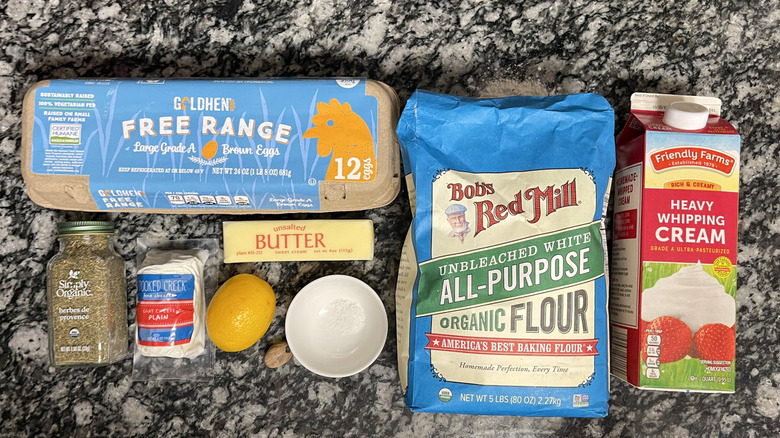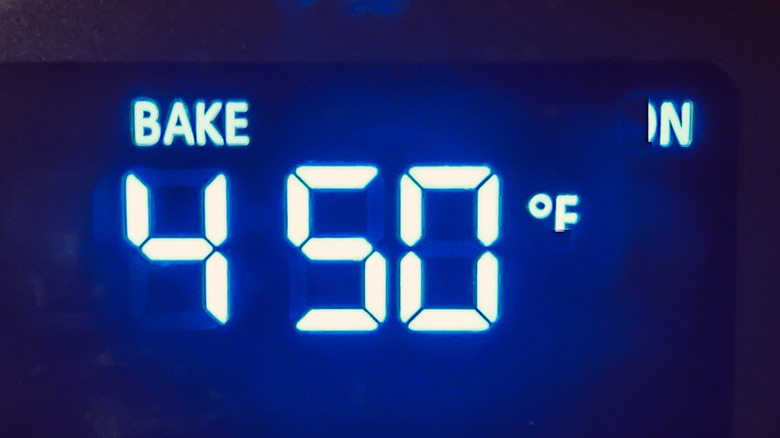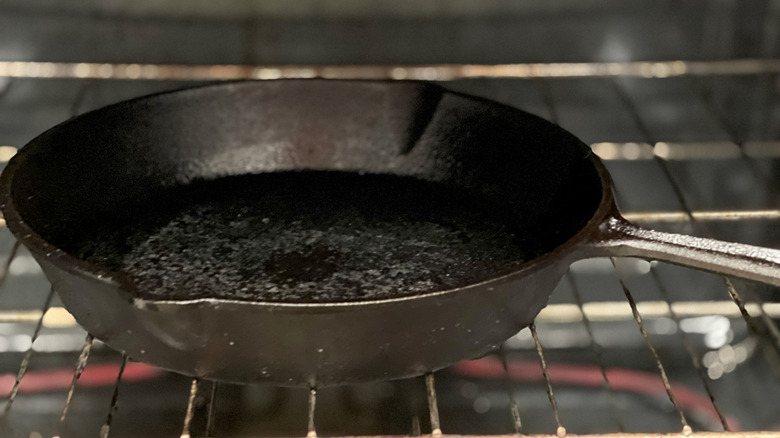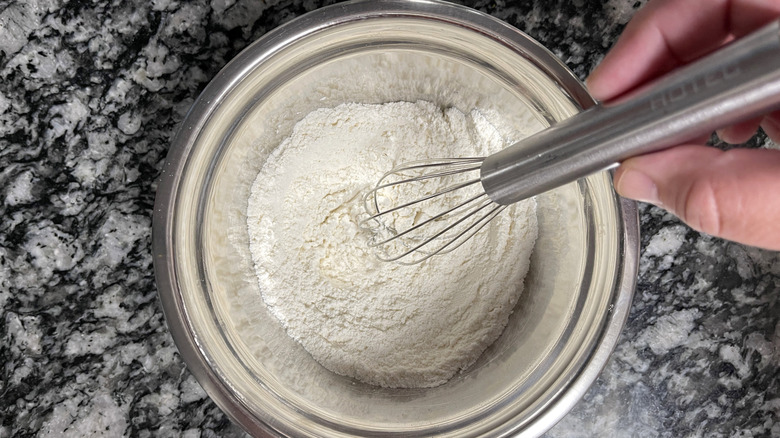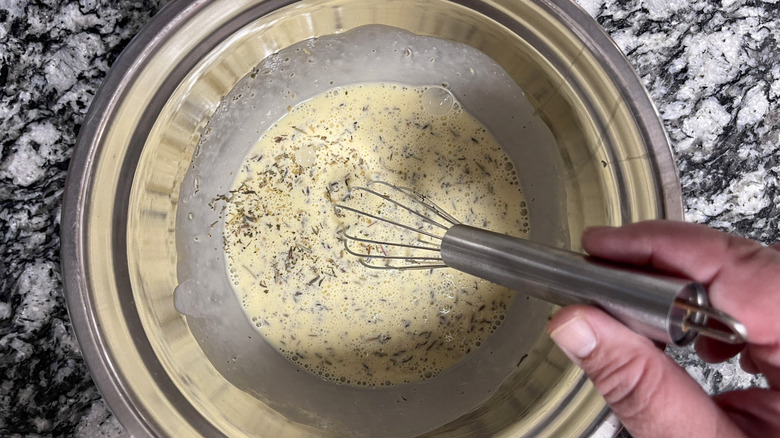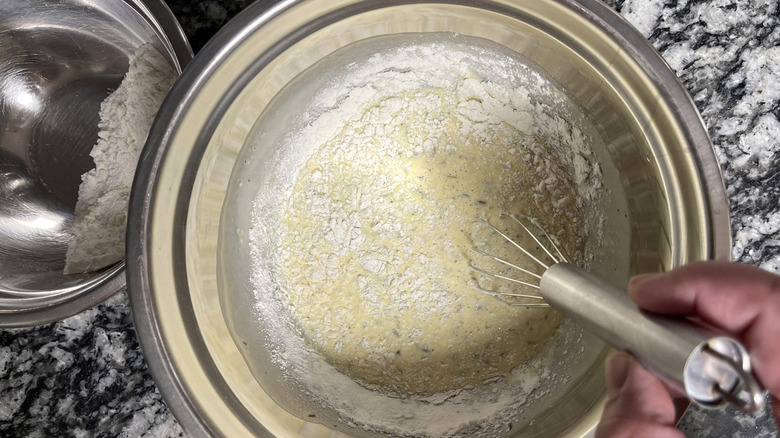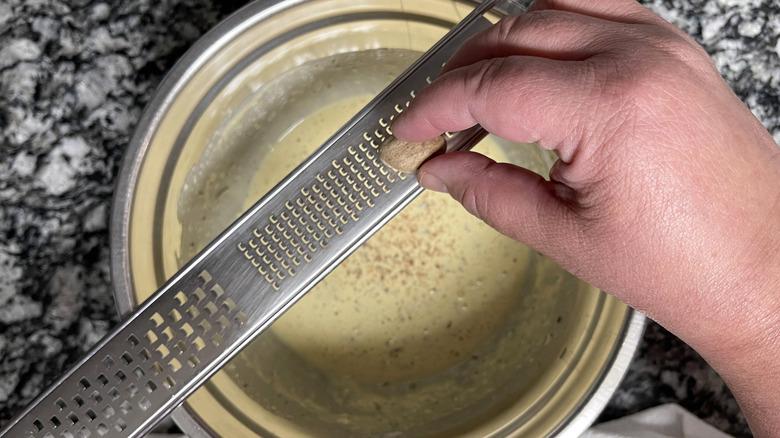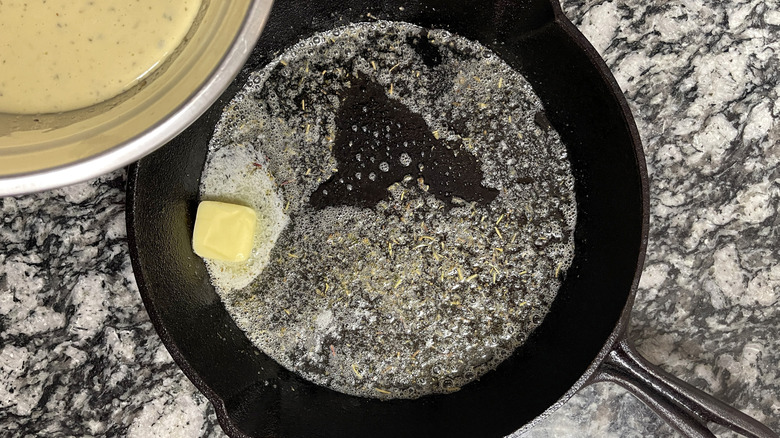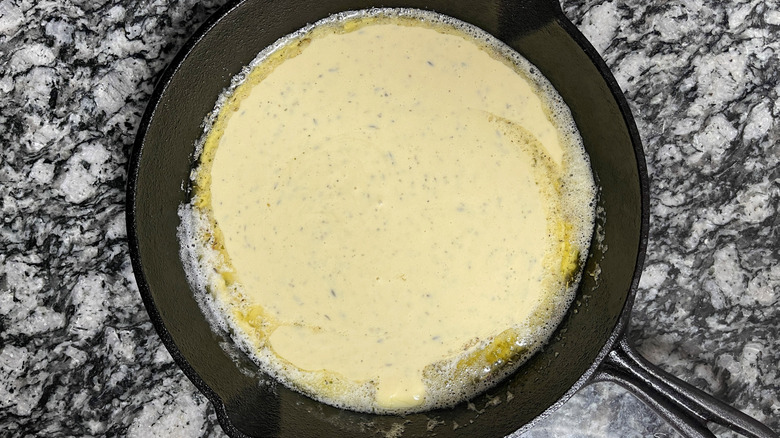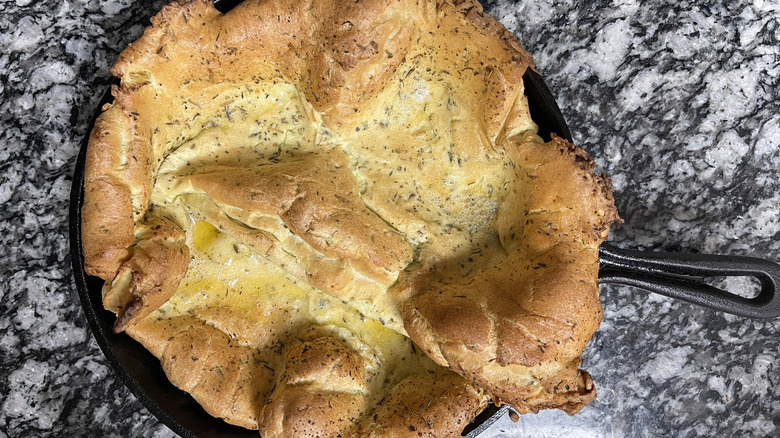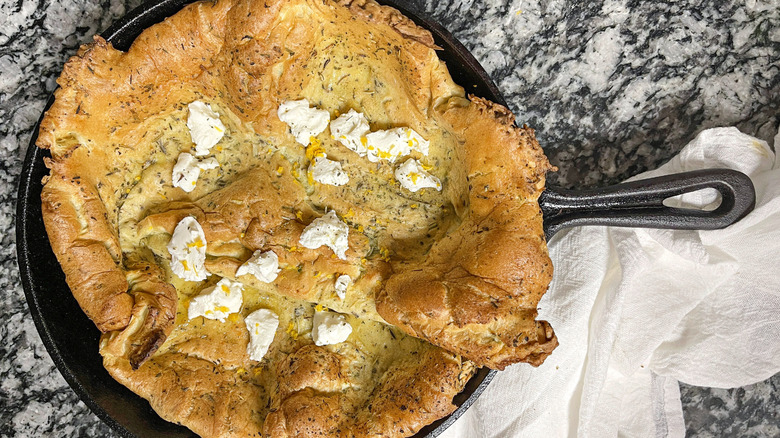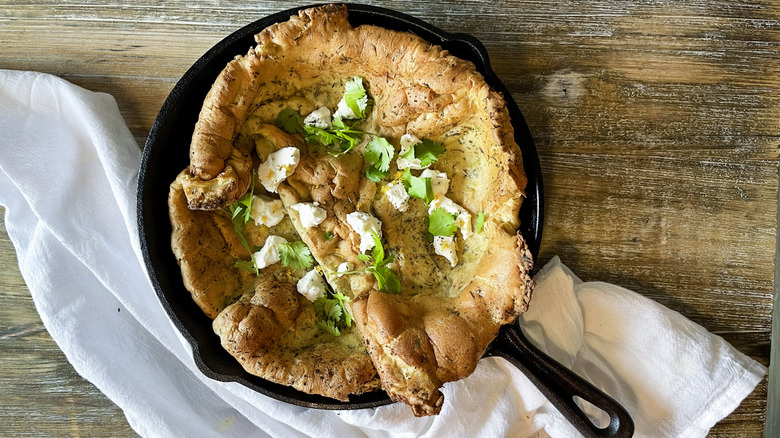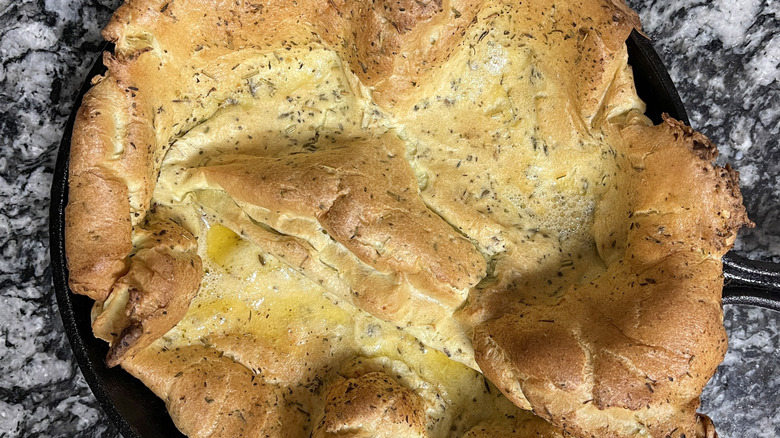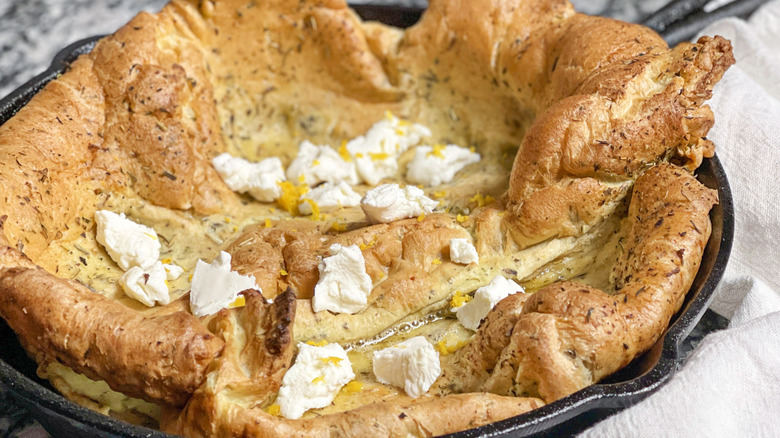Herbes De Provence And Tangy Goat Cheese Dutch Baby Recipe
A Dutch baby is a simple yet impressive dish that boasts a custardy tender interior and puffy crispy edges. It's perfect to customize with any of your favorite savory or sweet ingredients. Despite seemingly having ties to the Netherlands, is actually an American creation, and more specifically, a Seattle one. Similar to a German pancake (which is also partly why it's called a Dutch baby to begin with), this unique treat is something like a pancake, something like a souffle, something like a crepe, and even something like a Yorkshire pudding. Though we often see it served in a sweet, breakfast- or brunch-forward context, it can easily take on a savory profile, as it does in recipe developer Kara Barrett's herbes de Provence and tangy goat cheese Dutch baby recipe.
"This is such a fun brunch option and it looks very impressive," Barrett says, noting that "The tangy goat cheese and lemon zest really complement the earthy notes of the Herbes de Provence." Though this recipe is pretty simple, requiring not too many ingredients and only 30 minutes of your time, it really is a showstopper. Barrett advises, "Serve it with a simple salad dressed in a zippy vinaigrette. You can also pair it with a sparkling wine or mimosa for brunch. To make it more filling for dinner, try adding sliced steak or buttery or sauteed shrimp along with the goat cheese."
Gather the ingredients for this herbes de Provence and tangy goat cheese Dutch baby recipe
For the Dutch baby, you'll need all-purpose flour, salt, eggs, heavy cream or milk, herbes de Provence, and nutmeg, along with butter to grease the pan before cooking. To top off your Dutch baby, you'll want crumbled goat cheese and lemon zest, along with optional fresh herbs or salad greens for serving.
Step 1: Preheat the oven
Preheat the oven to 450 F.
Step 2: Heat the pan in the oven
Heat a cast iron pan in the oven for 15 minutes after the oven reaches the correct temperature. Your skillet needs to be piping hot.
Step 3: Begin making the Dutch baby batter
While the skillet or oven is heating, whisk together the flour and salt.
Step 4: Whisk wet ingredients and herbs
Vigorously whisk the eggs, milk, and 1 teaspoon of herbes de Provence until homogeneous.
Step 5: Form the batter
Combine the wet and dry ingredients and whisk well to incorporate air into the batter and remove any lumps. This can also be done in a blender.
Step 6: Grate in nutmeg
Add the nutmeg and set the batter aside.
Step 7: Swirl butter and herbs in hot pan
When the skillet is hot, immediately swirl in 2 tablespoons of butter with the remaining ½ teaspoon of Herbes de Provence.
Step 8: Pour batter into the skillet
Give the batter a little whisk if it's been sitting long, and then pour it into the piping-hot skillet.
Step 9: Bake the pancake
Bake undisturbed for 15 minutes.
Step 10: Top with goat cheese and lemon zest
Add the goat cheese and lemon zest while the Dutch Baby is hot.
Step 11: Garnish and serve
Serve warm with a sprinkle of fresh herbs or salad greens if desired.
Herbes de Provence and Tangy Goat Cheese Dutch Baby Recipe
This savory Dutch baby combines earthy herbes de Provence with tangy goat cheese for an easy yet impressive brunch, lunch, or light dinner.
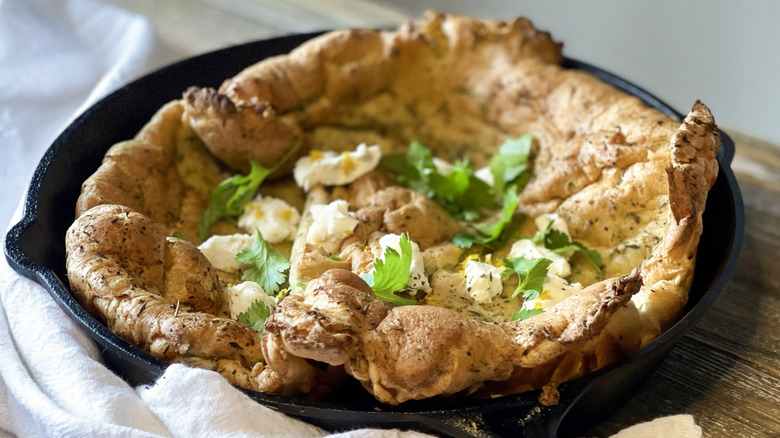
Ingredients
- ½ cup all-purpose flour
- ¼ teaspoon kosher salt
- 3 eggs, room temp
- ½ cup heavy cream or milk, room temp
- 1 ½ teaspoons of herbes de Provence, divided
- ⅛ teaspoon nutmeg
- 2 tablespoons unsalted butter
- 2 ounces goat cheese, crumbled
- ½ teaspoon lemon zest
Optional Ingredients
- Fresh herbs, for garnish
- Salad greens, to serve
Directions
- Preheat the oven to 450 F.
- Heat a cast iron pan in the oven for 15 minutes after the oven reaches the correct temperature. Your skillet needs to be piping hot.
- While the skillet or oven is heating, whisk together the flour and salt.
- Vigorously whisk the eggs, milk, and 1 teaspoon of herbes de Provence until homogeneous.
- Combine the wet and dry ingredients and whisk well to incorporate air into the batter and remove any lumps. This can also be done in a blender.
- Add the nutmeg and set the batter aside.
- When the skillet is hot, immediately swirl in 2 tablespoons of butter with the remaining ½ teaspoon of Herbes de Provence.
- Give the batter a little whisk if it's been sitting long, and then pour it into the piping-hot skillet.
- Bake undisturbed for 15 minutes.
- Add the goat cheese and lemon zest while the Dutch Baby is hot.
- Serve warm with a sprinkle of fresh herbs or salad greens if desired.
What can I do if my Dutch Baby doesn't rise?
Unlike American pancakes or crepes, a puffy, risen crust is essential to a Dutch baby. Achieving such a puffy Dutch baby might seem like the ultimate challenge for some home chefs, though Barrett assures us that with proper care, you can make sure your Dutch baby rises successfully every time you make one. "Make sure you have whipped enough air into your batter and that you are using a piping hot skillet," Barrett advises for starters, explaining that using a larger whisk will help you to incorporate more air into the batter.
Noting that a Dutch baby rises in the oven thanks to steam, Barrett warns not to crack open your oven and sneak a peek as the Dutch baby cooks — even for just a second — otherwise you risk letting out some of that precious steam. Keep that oven door closed and, if you must, turn on the oven light and admire your Dutch baby without opening the oven door.
As a final tip, make sure that you're using both room-temperature eggs and cream (or milk) in your batter. "This aids in emulsification and helps create a batter that will steam and rise," Barrett explains.
What substitutions can I make in this Dutch baby?
Goat cheese works wonderfully in this Dutch baby recipe, adding a savory, tangy, and sharp contrast to an otherwise custardy and herb-forward dish. That said, goat cheese isn't everyone's cup of tea, or perhaps you simply don't have it stocked in your fridge. "If goat cheese isn't available, try feta or ricotta for a similar creamy and tangy taste," Barrett recommends. She also notes that mascarpone or crème fraîche are good alternatives if you want something with a milder flavor, and you could even use sour cream in a pinch.
Perhaps you're perfectly content with the goat cheese, but there's another key component to this recipe that you'd like to switch up: the herbs. "Herbes de Provence blends vary but usually include a mix of dried herbs like marjoram, rosemary, savory, tarragon, thyme, parsley, and lavender," Barrett says. So, the easiest thing to do is use a store-bought blend, but if you don't like one or two of the herbs in the mix, you can easily make a homemade version and omit the ones you don't like. You could always just use one or two of your favorite herbs — thyme, rosemary, and tarragon are all good choices to complement the goat cheese in this recipe.
